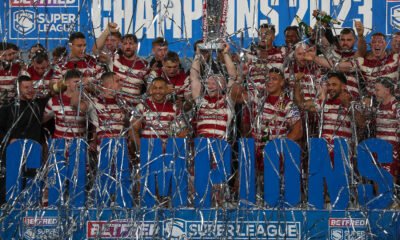
The start of the summer era of the game was no silver lining for one particular club: rather a continuation of the storm. After rejecting the idea of merging into a Cumbrian powerhouse team alongside Carlisle, Whitehaven and Barrow, Workington Town struck out in the first year of Super League on their own.
But it was to be in vain. Workington didn’t make any impact in their first, and only, season in Super League and would finish twelfth, meaning they would play in Division One for the 1997 season. Things would go from bad to worse for the club as they finished eleventh that year, and were relegated into Division Two for the 1998 campaign, where they would remain for the next fourteen years.
2012 signalled a change of fortune for the club as they finished third and achieved promotion to the Championship. This was made possible because the top four teams of Championship 1 (as it was then known) were given promoted status. However, after losing 17 games out of 23 and a poor display in the Championship Shield, Workington would once again run out as a League Two team for the 2017 season. They almost got back to the Championship the following year but lost in the Promotion Final. This has been the closest Workington have got to climbing up the league ladder. Let’s look back to see where it went wrong for the men from Cumbria.
In December 1944, the world was in the grips of the fiercest conflict in history. Nazi forces were putting up fierce resistance against American troops in the Ardennes Forest, France, in an offensive more commonly known as the Battle of the Bulge. The first bombing raids were being flown over Iwo Jima in the Pacific in preparation for the hellish battle that would come the following spring, and British and Red Army forces were continuing to push the Nazis closer and closer to Berlin. Auschwitz would be liberated just over a month later. But in the midst of the colossal upheaval in the Pacific and Europe, life on the British home-front carried on.
Despite the fact that many sports teams had lost some of their players to the armed forces, a consortium of businessmen, primarily made up of officials affiliated with Workington Town football club, put forward their ideas for a Rugby League club. The first of two meetings would take place at the Royal Oak Hotel in the town, before a follow-up was held at The Grosvenor Hotel, Manchester, on the 23rd of January 1945. It was decided in this meeting that an application to the Rugby Football League would be submitted, birthing the first club from Cumbria to play in British Rugby League.
Fast forward six years and Workington Town would be the best team in the competition. No team has ever gone from formation to such huge success in Rugby League history. They became League Champions in 1951 after beating Warrington in Manchester, which they would follow up with a Challenge Cup victory the following year. Played in front of over 72,000 fans at Wembley against Featherstone with a score line of 18-10, it would be the pinnacle of Workington’s success. They also have the honour of being part of the first televised Challenge Cup in British broadcasting history. Throughout the fifties and into the sixties, Workington still contested for finals but would never again reach the heights of the 1951 and 1952 seasons.
In the seventies, Workington would fall away from being a week-in-week-out-competitor in the game. They suffered an alarming drop in supporter numbers which meant they were starting to struggle financially. The knock on effect of this meant Workington didn’t have the strength to attract big names to the club. Workington found themselves being forced to nurture home-grown talent which started to work for the club. They started appearing in finals again, culminating in a promotion back to the top-flight, and a Lancashire Cup victory in 1977 against Wigan, once again proving they could mix it with the big boys. Cruelly, as Workington were gaining attention once more, so were their players, and many were enticed away to bigger clubs.
The eighties were a dismal time for Workington as fans didn’t turn up, putting more financial pressure on the club, and their instability meant that they were constantly going up and down between League 1 and League 2. As the nineties dawned, Workington found themselves in the third tier of British Rugby League. But the only way was up, quite literally, and Workington were starting to gain traction yet again. They claimed the Second Division Championship and the Divisional Premiership Trophy double in 1993-1994 and achieved promotion back into the top flight once again at the dawn of the Super League.
Workington only won two games all season and were the first team to be relegated from Super League. At this point they had crushing debts once more but just like in the seventies, Workington would survive. This was in no small part to a Challenge Cup tie against Leeds, the huge crowds from which would clear Workington’s arrears. In 2002 they would drop to League Two once more.
After two consecutive seasons of finishing third in League Two, Workington found themselves back in the Championship in 2013 and two years later, they would finish fourth in the Championship Shield, but would never make it into the top half of the league. In 2017, they would once again be in League 1 and with fourth and fifth placed finishes in the 2018 and 2019 seasons respectively, plus appearances in both finals of that year, things are looking good again for Workington.
From a team that was created in a time of so much strife, climbing to the top of the mountain at Wembley before crashing back down to the lowest level in the game, Workington have had to deal with a lot of inconsistency and financial hardship. The chance of playing in the re-branded Super League was not the success that fans hoped it would be. Instead, there have been less than few occasions where they have looked close to coming back.
A second round thumping at the hands of Leigh Centurions in the 2019 1895 Cup is a good recent reflection of the vast gulf of effort that Workington would need to commit to, to get back into Super League. What cannot be denied though is that Workington are still a vital part of the Cumbrian contingent. With their history showing as higher troughs as peaks, in time, Workington could be back in Super League one day, but there is a long way to go until that happens.




























